M&S Management & Operations: Leadership, Strategies, Analysis
VerifiedAdded on 2023/01/07
|17
|4663
|98
Report
AI Summary
This report provides an overview of management and operations within Marks and Spencer (M&S), a British multinational company. It examines the roles and characteristics of managers and leaders, emphasizing their impact on achieving business profitability and efficacy. The report delves into various leadership styles such as situational, systems, and Fiedler's contingency models, evaluating their strengths and weaknesses in the context of M&S. Furthermore, it analyzes how different business environments, including stable and rapidly changing conditions like those influenced by Brexit, affect decision-making processes. The report highlights the importance of adapting leadership and management strategies to maintain competitiveness and achieve organizational goals within dynamic market conditions.
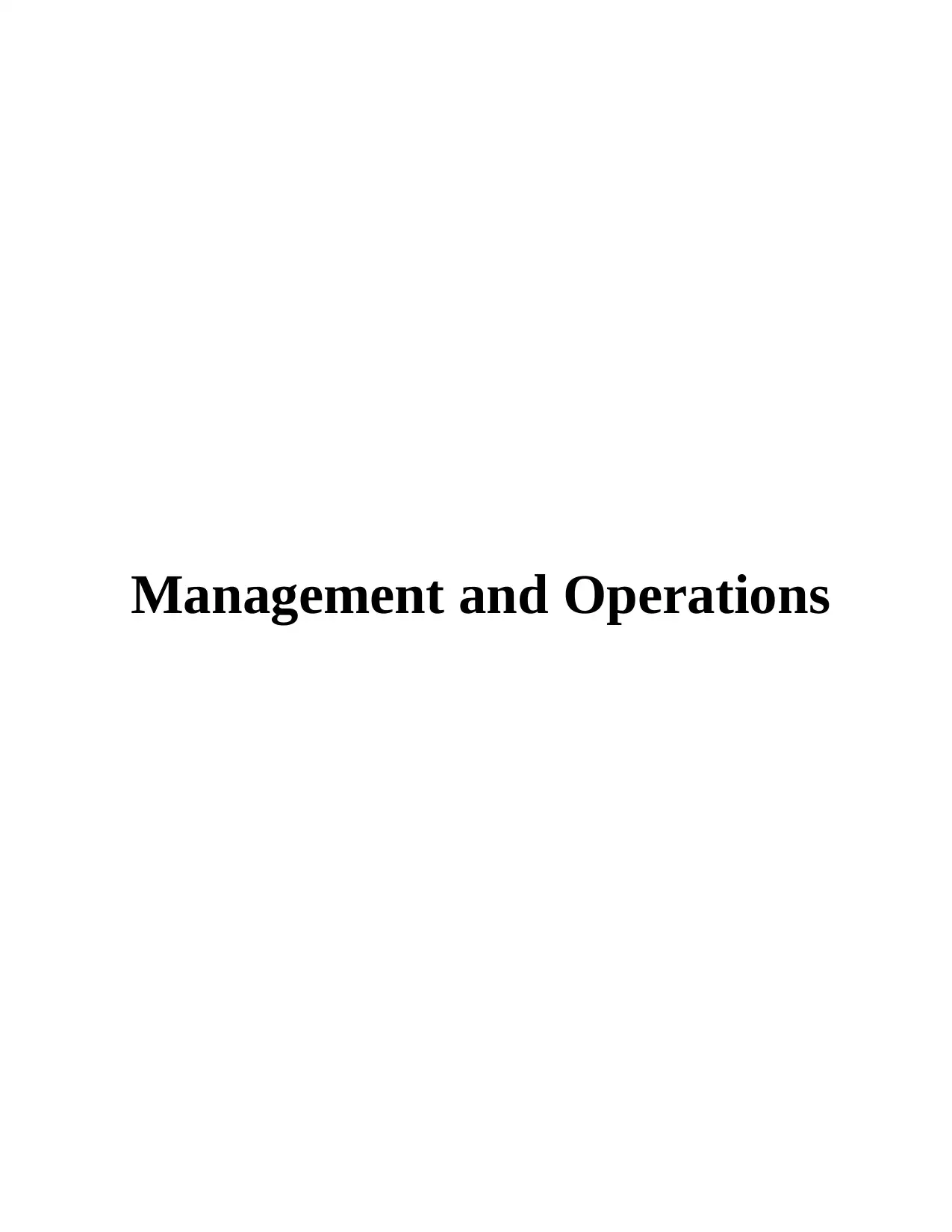
Management and Operations
Paraphrase This Document
Need a fresh take? Get an instant paraphrase of this document with our AI Paraphraser

Table of Contents
INTRODUCTION.........................................................................................................................3
PART 1..........................................................................................................................................3
P1...............................................................................................................................................3
P2...............................................................................................................................................5
P3 ..............................................................................................................................................7
PART 2..........................................................................................................................................9
P4...............................................................................................................................................9
P5.............................................................................................................................................11
P6.............................................................................................................................................13
CONCLUSION ...........................................................................................................................15
REFERENCES ...........................................................................................................................16
INTRODUCTION.........................................................................................................................3
PART 1..........................................................................................................................................3
P1...............................................................................................................................................3
P2...............................................................................................................................................5
P3 ..............................................................................................................................................7
PART 2..........................................................................................................................................9
P4...............................................................................................................................................9
P5.............................................................................................................................................11
P6.............................................................................................................................................13
CONCLUSION ...........................................................................................................................15
REFERENCES ...........................................................................................................................16

INTRODUCTION
Operation & management is defined as shifting of raw material and different resources
in order to convert them into finished goods so for the major purpose to accomplish high gain
and marketplace image. These processes are emphasised on reinstating business offerings and
to design the same along with needs and demand of customer so as to maintain and develop
high profitability as well (Burns, 2018). Management and operation is helping the business in
achieving profitability and efficacy. This report is associated with major concepts of
management and operation along with view point of M&S which is a British multinational
company and associated with dealing in wearables, pre-packaged food and fashionable home
décor items. M&S is having their headquarter in Westminster, UK. This report includes various
functions and characteristics of manager and leader in M&S along with importance of operation
management. Along with this the report includes impact within decision making of business
environment.
PART 1
P1.
Leader: A leader is personnel who are having high end capabilities of getting the task
done by others just by motivating them and giving them ample amount of directions. Along
with appropriate leadership styles overall goals of a business can be attained with efficacy. In
the reference of M&S the leaders are providing assistance to the business so as to lead them in
achieving tasks in performed manner. Leaders are guiding for the company and they
subsistence their overall responsibility towards helping employees in training and learning
programs.
Manager: A manager is known as the person who is responsible to monitor & manage
business activities in order to make them executes with employees. High responsibility of
business management is executed by manager in order to operate business activities in
proficient manner. In the background of M&S the manager is taking responsibility of providing
direction to the employees in which their directions are aligned towards overall plans and aims.
Operation & management is defined as shifting of raw material and different resources
in order to convert them into finished goods so for the major purpose to accomplish high gain
and marketplace image. These processes are emphasised on reinstating business offerings and
to design the same along with needs and demand of customer so as to maintain and develop
high profitability as well (Burns, 2018). Management and operation is helping the business in
achieving profitability and efficacy. This report is associated with major concepts of
management and operation along with view point of M&S which is a British multinational
company and associated with dealing in wearables, pre-packaged food and fashionable home
décor items. M&S is having their headquarter in Westminster, UK. This report includes various
functions and characteristics of manager and leader in M&S along with importance of operation
management. Along with this the report includes impact within decision making of business
environment.
PART 1
P1.
Leader: A leader is personnel who are having high end capabilities of getting the task
done by others just by motivating them and giving them ample amount of directions. Along
with appropriate leadership styles overall goals of a business can be attained with efficacy. In
the reference of M&S the leaders are providing assistance to the business so as to lead them in
achieving tasks in performed manner. Leaders are guiding for the company and they
subsistence their overall responsibility towards helping employees in training and learning
programs.
Manager: A manager is known as the person who is responsible to monitor & manage
business activities in order to make them executes with employees. High responsibility of
business management is executed by manager in order to operate business activities in
proficient manner. In the background of M&S the manager is taking responsibility of providing
direction to the employees in which their directions are aligned towards overall plans and aims.
⊘ This is a preview!⊘
Do you want full access?
Subscribe today to unlock all pages.

Trusted by 1+ million students worldwide
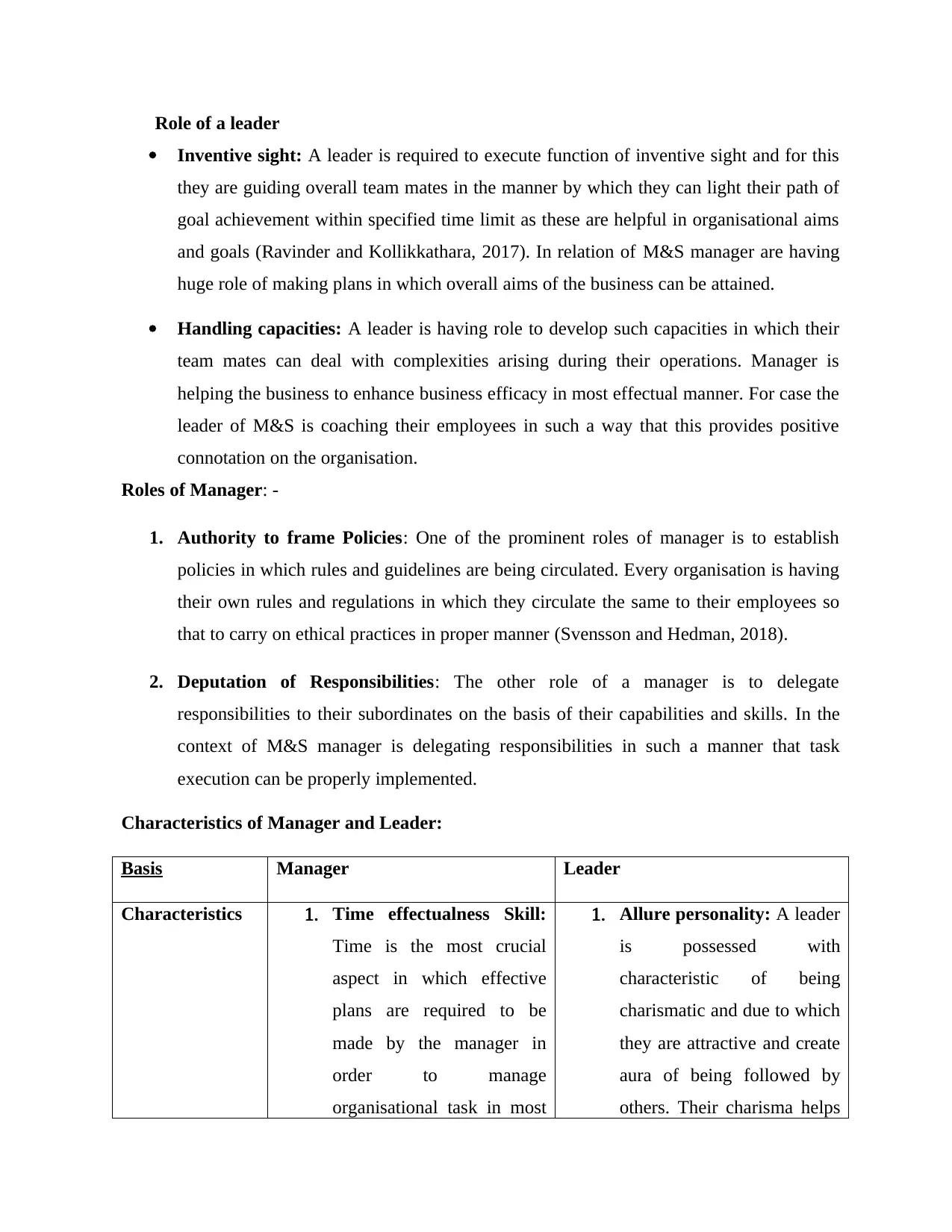
Role of a leader
Inventive sight: A leader is required to execute function of inventive sight and for this
they are guiding overall team mates in the manner by which they can light their path of
goal achievement within specified time limit as these are helpful in organisational aims
and goals (Ravinder and Kollikkathara, 2017). In relation of M&S manager are having
huge role of making plans in which overall aims of the business can be attained.
Handling capacities: A leader is having role to develop such capacities in which their
team mates can deal with complexities arising during their operations. Manager is
helping the business to enhance business efficacy in most effectual manner. For case the
leader of M&S is coaching their employees in such a way that this provides positive
connotation on the organisation.
Roles of Manager: -
1. Authority to frame Policies: One of the prominent roles of manager is to establish
policies in which rules and guidelines are being circulated. Every organisation is having
their own rules and regulations in which they circulate the same to their employees so
that to carry on ethical practices in proper manner (Svensson and Hedman, 2018).
2. Deputation of Responsibilities: The other role of a manager is to delegate
responsibilities to their subordinates on the basis of their capabilities and skills. In the
context of M&S manager is delegating responsibilities in such a manner that task
execution can be properly implemented.
Characteristics of Manager and Leader:
Basis Manager Leader
Characteristics 1. Time effectualness Skill:
Time is the most crucial
aspect in which effective
plans are required to be
made by the manager in
order to manage
organisational task in most
1. Allure personality: A leader
is possessed with
characteristic of being
charismatic and due to which
they are attractive and create
aura of being followed by
others. Their charisma helps
Inventive sight: A leader is required to execute function of inventive sight and for this
they are guiding overall team mates in the manner by which they can light their path of
goal achievement within specified time limit as these are helpful in organisational aims
and goals (Ravinder and Kollikkathara, 2017). In relation of M&S manager are having
huge role of making plans in which overall aims of the business can be attained.
Handling capacities: A leader is having role to develop such capacities in which their
team mates can deal with complexities arising during their operations. Manager is
helping the business to enhance business efficacy in most effectual manner. For case the
leader of M&S is coaching their employees in such a way that this provides positive
connotation on the organisation.
Roles of Manager: -
1. Authority to frame Policies: One of the prominent roles of manager is to establish
policies in which rules and guidelines are being circulated. Every organisation is having
their own rules and regulations in which they circulate the same to their employees so
that to carry on ethical practices in proper manner (Svensson and Hedman, 2018).
2. Deputation of Responsibilities: The other role of a manager is to delegate
responsibilities to their subordinates on the basis of their capabilities and skills. In the
context of M&S manager is delegating responsibilities in such a manner that task
execution can be properly implemented.
Characteristics of Manager and Leader:
Basis Manager Leader
Characteristics 1. Time effectualness Skill:
Time is the most crucial
aspect in which effective
plans are required to be
made by the manager in
order to manage
organisational task in most
1. Allure personality: A leader
is possessed with
characteristic of being
charismatic and due to which
they are attractive and create
aura of being followed by
others. Their charisma helps
Paraphrase This Document
Need a fresh take? Get an instant paraphrase of this document with our AI Paraphraser
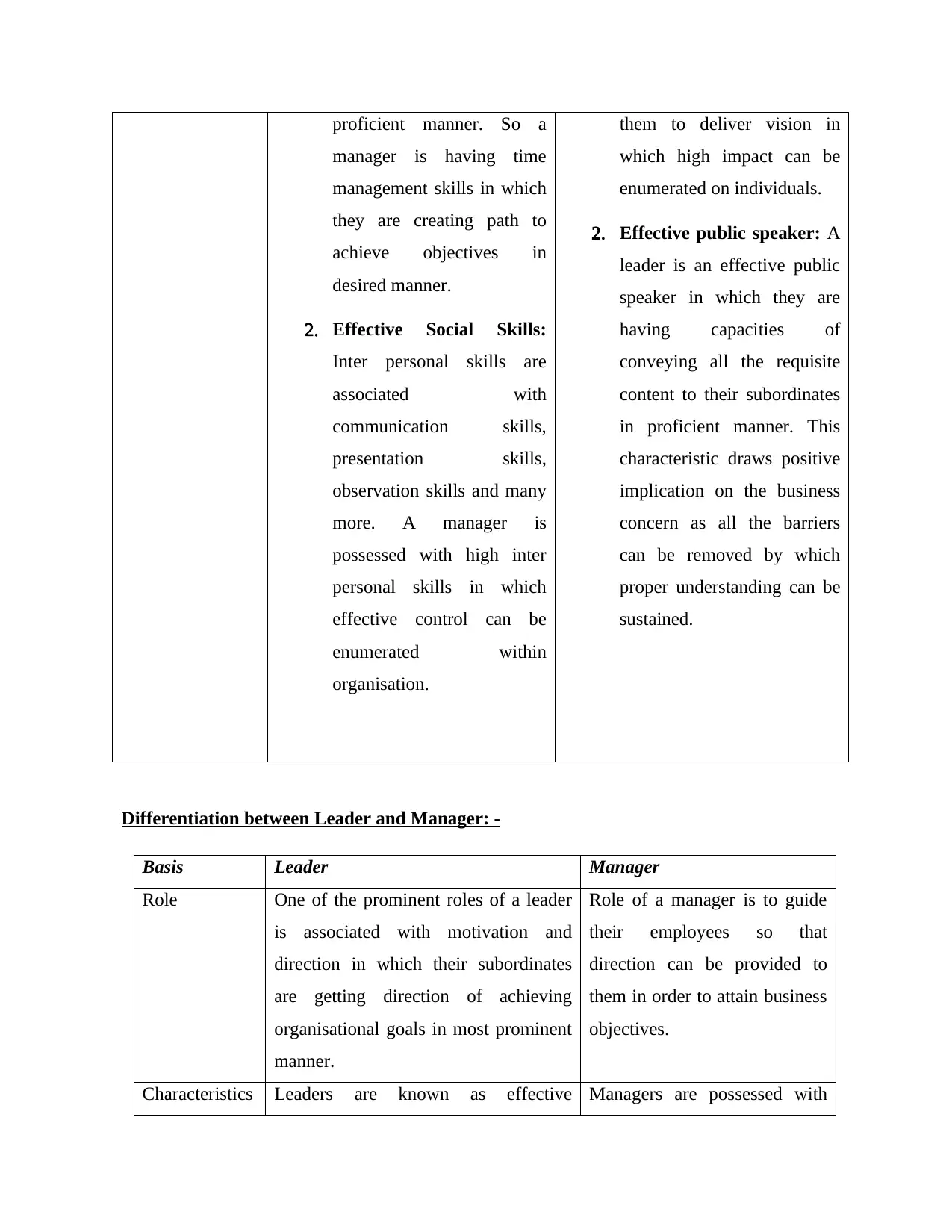
proficient manner. So a
manager is having time
management skills in which
they are creating path to
achieve objectives in
desired manner.
2. Effective Social Skills:
Inter personal skills are
associated with
communication skills,
presentation skills,
observation skills and many
more. A manager is
possessed with high inter
personal skills in which
effective control can be
enumerated within
organisation.
them to deliver vision in
which high impact can be
enumerated on individuals.
2. Effective public speaker: A
leader is an effective public
speaker in which they are
having capacities of
conveying all the requisite
content to their subordinates
in proficient manner. This
characteristic draws positive
implication on the business
concern as all the barriers
can be removed by which
proper understanding can be
sustained.
Differentiation between Leader and Manager: -
Basis Leader Manager
Role One of the prominent roles of a leader
is associated with motivation and
direction in which their subordinates
are getting direction of achieving
organisational goals in most prominent
manner.
Role of a manager is to guide
their employees so that
direction can be provided to
them in order to attain business
objectives.
Characteristics Leaders are known as effective Managers are possessed with
manager is having time
management skills in which
they are creating path to
achieve objectives in
desired manner.
2. Effective Social Skills:
Inter personal skills are
associated with
communication skills,
presentation skills,
observation skills and many
more. A manager is
possessed with high inter
personal skills in which
effective control can be
enumerated within
organisation.
them to deliver vision in
which high impact can be
enumerated on individuals.
2. Effective public speaker: A
leader is an effective public
speaker in which they are
having capacities of
conveying all the requisite
content to their subordinates
in proficient manner. This
characteristic draws positive
implication on the business
concern as all the barriers
can be removed by which
proper understanding can be
sustained.
Differentiation between Leader and Manager: -
Basis Leader Manager
Role One of the prominent roles of a leader
is associated with motivation and
direction in which their subordinates
are getting direction of achieving
organisational goals in most prominent
manner.
Role of a manager is to guide
their employees so that
direction can be provided to
them in order to attain business
objectives.
Characteristics Leaders are known as effective Managers are possessed with
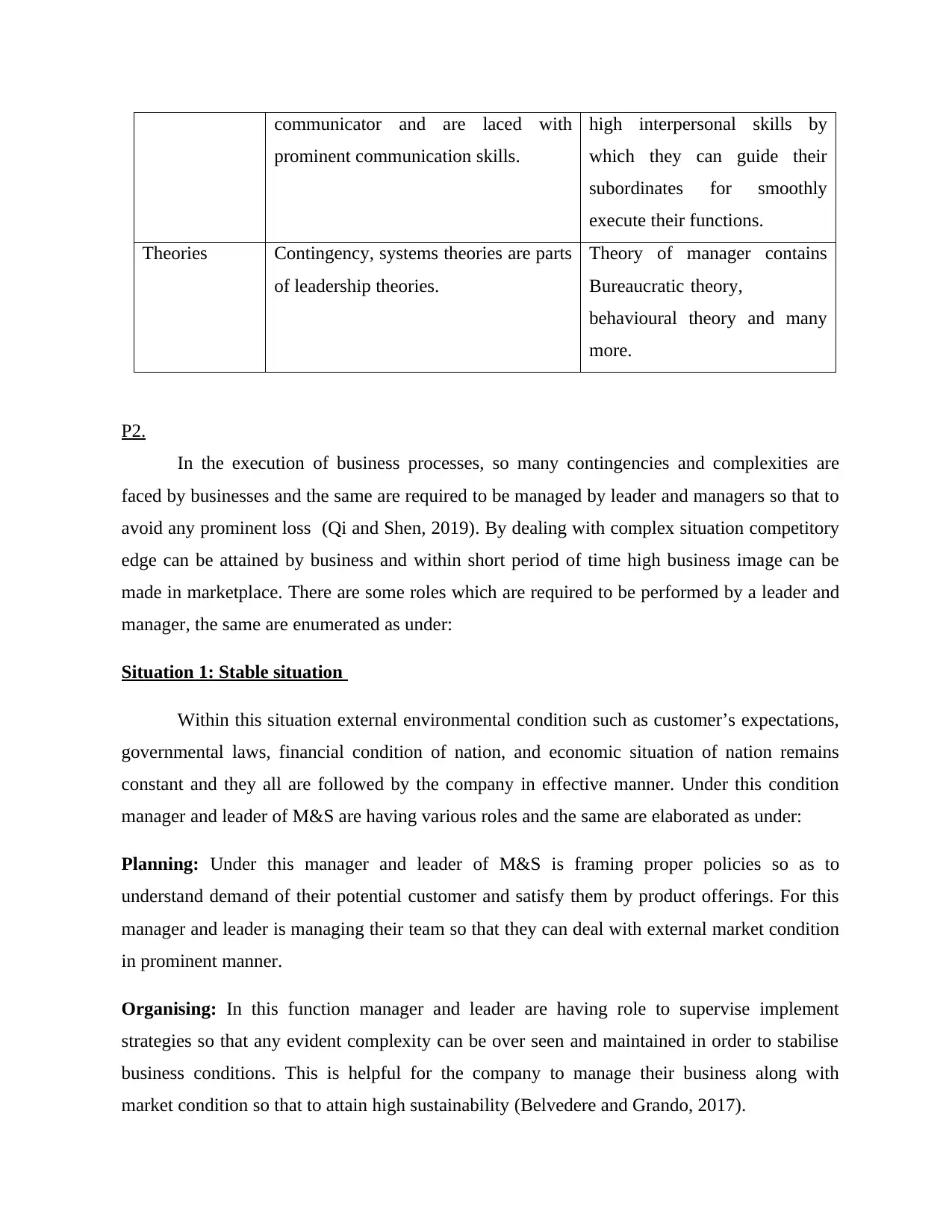
communicator and are laced with
prominent communication skills.
high interpersonal skills by
which they can guide their
subordinates for smoothly
execute their functions.
Theories Contingency, systems theories are parts
of leadership theories.
Theory of manager contains
Bureaucratic theory,
behavioural theory and many
more.
P2.
In the execution of business processes, so many contingencies and complexities are
faced by businesses and the same are required to be managed by leader and managers so that to
avoid any prominent loss (Qi and Shen, 2019). By dealing with complex situation competitory
edge can be attained by business and within short period of time high business image can be
made in marketplace. There are some roles which are required to be performed by a leader and
manager, the same are enumerated as under:
Situation 1: Stable situation
Within this situation external environmental condition such as customer’s expectations,
governmental laws, financial condition of nation, and economic situation of nation remains
constant and they all are followed by the company in effective manner. Under this condition
manager and leader of M&S are having various roles and the same are elaborated as under:
Planning: Under this manager and leader of M&S is framing proper policies so as to
understand demand of their potential customer and satisfy them by product offerings. For this
manager and leader is managing their team so that they can deal with external market condition
in prominent manner.
Organising: In this function manager and leader are having role to supervise implement
strategies so that any evident complexity can be over seen and maintained in order to stabilise
business conditions. This is helpful for the company to manage their business along with
market condition so that to attain high sustainability (Belvedere and Grando, 2017).
prominent communication skills.
high interpersonal skills by
which they can guide their
subordinates for smoothly
execute their functions.
Theories Contingency, systems theories are parts
of leadership theories.
Theory of manager contains
Bureaucratic theory,
behavioural theory and many
more.
P2.
In the execution of business processes, so many contingencies and complexities are
faced by businesses and the same are required to be managed by leader and managers so that to
avoid any prominent loss (Qi and Shen, 2019). By dealing with complex situation competitory
edge can be attained by business and within short period of time high business image can be
made in marketplace. There are some roles which are required to be performed by a leader and
manager, the same are enumerated as under:
Situation 1: Stable situation
Within this situation external environmental condition such as customer’s expectations,
governmental laws, financial condition of nation, and economic situation of nation remains
constant and they all are followed by the company in effective manner. Under this condition
manager and leader of M&S are having various roles and the same are elaborated as under:
Planning: Under this manager and leader of M&S is framing proper policies so as to
understand demand of their potential customer and satisfy them by product offerings. For this
manager and leader is managing their team so that they can deal with external market condition
in prominent manner.
Organising: In this function manager and leader are having role to supervise implement
strategies so that any evident complexity can be over seen and maintained in order to stabilise
business conditions. This is helpful for the company to manage their business along with
market condition so that to attain high sustainability (Belvedere and Grando, 2017).
⊘ This is a preview!⊘
Do you want full access?
Subscribe today to unlock all pages.

Trusted by 1+ million students worldwide
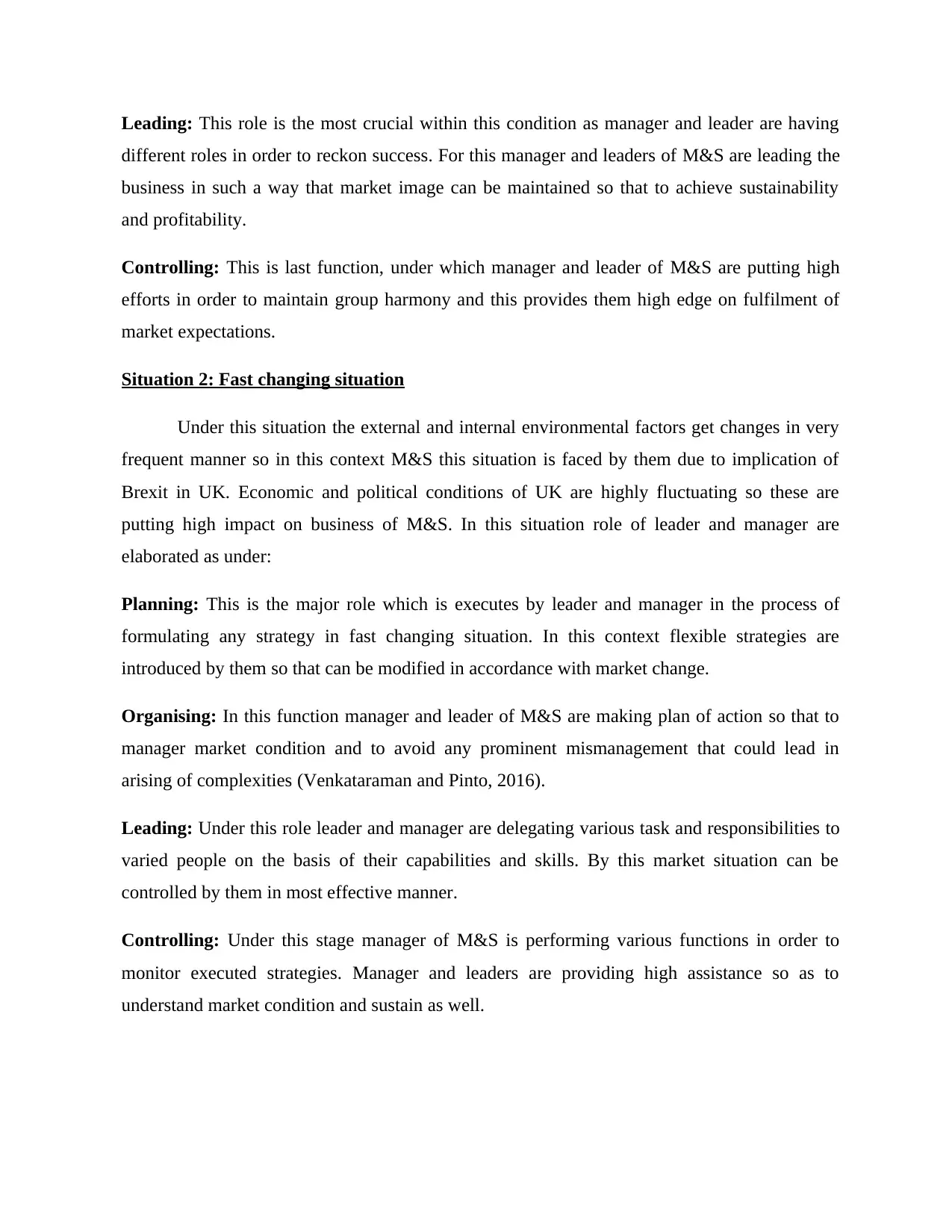
Leading: This role is the most crucial within this condition as manager and leader are having
different roles in order to reckon success. For this manager and leaders of M&S are leading the
business in such a way that market image can be maintained so that to achieve sustainability
and profitability.
Controlling: This is last function, under which manager and leader of M&S are putting high
efforts in order to maintain group harmony and this provides them high edge on fulfilment of
market expectations.
Situation 2: Fast changing situation
Under this situation the external and internal environmental factors get changes in very
frequent manner so in this context M&S this situation is faced by them due to implication of
Brexit in UK. Economic and political conditions of UK are highly fluctuating so these are
putting high impact on business of M&S. In this situation role of leader and manager are
elaborated as under:
Planning: This is the major role which is executes by leader and manager in the process of
formulating any strategy in fast changing situation. In this context flexible strategies are
introduced by them so that can be modified in accordance with market change.
Organising: In this function manager and leader of M&S are making plan of action so that to
manager market condition and to avoid any prominent mismanagement that could lead in
arising of complexities (Venkataraman and Pinto, 2016).
Leading: Under this role leader and manager are delegating various task and responsibilities to
varied people on the basis of their capabilities and skills. By this market situation can be
controlled by them in most effective manner.
Controlling: Under this stage manager of M&S is performing various functions in order to
monitor executed strategies. Manager and leaders are providing high assistance so as to
understand market condition and sustain as well.
different roles in order to reckon success. For this manager and leaders of M&S are leading the
business in such a way that market image can be maintained so that to achieve sustainability
and profitability.
Controlling: This is last function, under which manager and leader of M&S are putting high
efforts in order to maintain group harmony and this provides them high edge on fulfilment of
market expectations.
Situation 2: Fast changing situation
Under this situation the external and internal environmental factors get changes in very
frequent manner so in this context M&S this situation is faced by them due to implication of
Brexit in UK. Economic and political conditions of UK are highly fluctuating so these are
putting high impact on business of M&S. In this situation role of leader and manager are
elaborated as under:
Planning: This is the major role which is executes by leader and manager in the process of
formulating any strategy in fast changing situation. In this context flexible strategies are
introduced by them so that can be modified in accordance with market change.
Organising: In this function manager and leader of M&S are making plan of action so that to
manager market condition and to avoid any prominent mismanagement that could lead in
arising of complexities (Venkataraman and Pinto, 2016).
Leading: Under this role leader and manager are delegating various task and responsibilities to
varied people on the basis of their capabilities and skills. By this market situation can be
controlled by them in most effective manner.
Controlling: Under this stage manager of M&S is performing various functions in order to
monitor executed strategies. Manager and leaders are providing high assistance so as to
understand market condition and sustain as well.
Paraphrase This Document
Need a fresh take? Get an instant paraphrase of this document with our AI Paraphraser
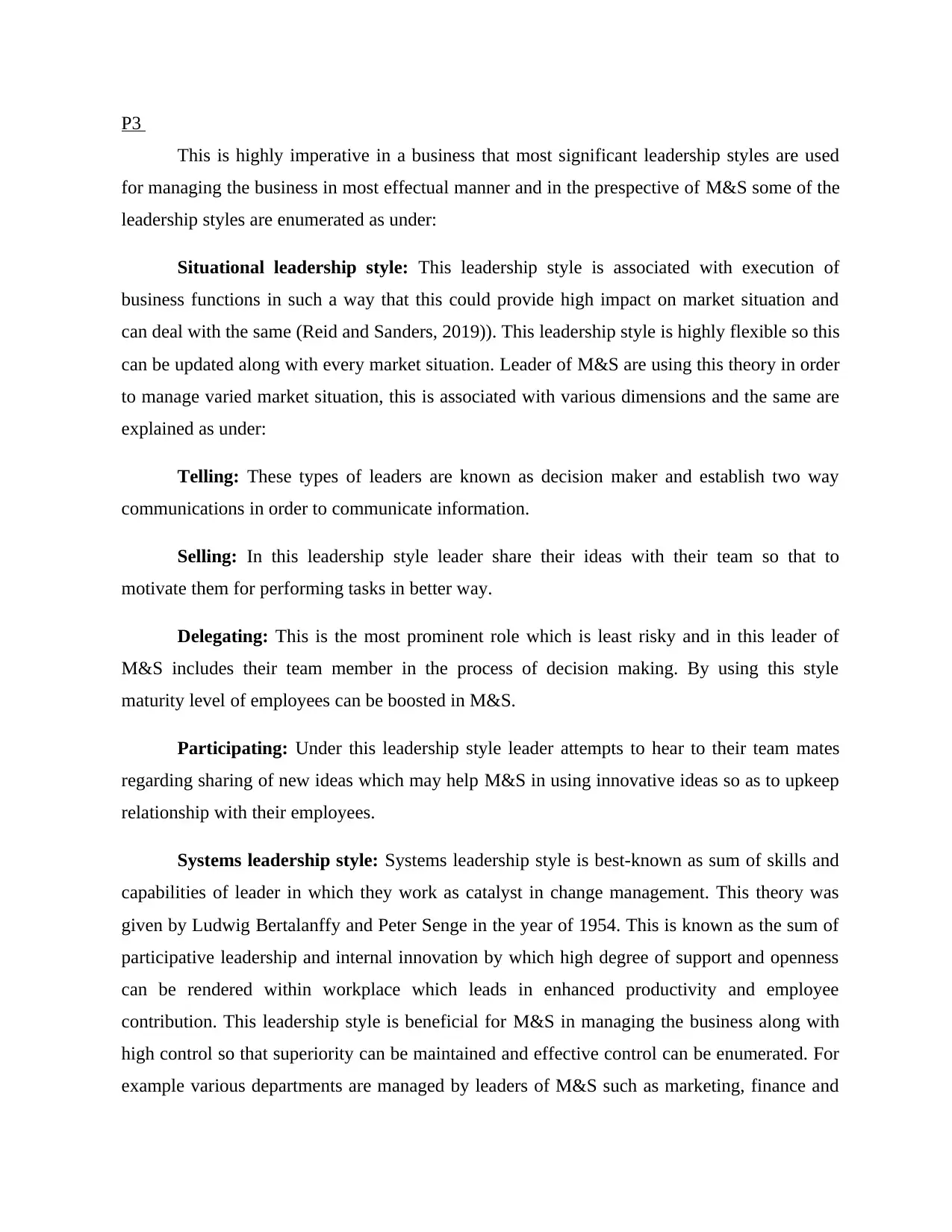
P3
This is highly imperative in a business that most significant leadership styles are used
for managing the business in most effectual manner and in the prespective of M&S some of the
leadership styles are enumerated as under:
Situational leadership style: This leadership style is associated with execution of
business functions in such a way that this could provide high impact on market situation and
can deal with the same (Reid and Sanders, 2019)). This leadership style is highly flexible so this
can be updated along with every market situation. Leader of M&S are using this theory in order
to manage varied market situation, this is associated with various dimensions and the same are
explained as under:
Telling: These types of leaders are known as decision maker and establish two way
communications in order to communicate information.
Selling: In this leadership style leader share their ideas with their team so that to
motivate them for performing tasks in better way.
Delegating: This is the most prominent role which is least risky and in this leader of
M&S includes their team member in the process of decision making. By using this style
maturity level of employees can be boosted in M&S.
Participating: Under this leadership style leader attempts to hear to their team mates
regarding sharing of new ideas which may help M&S in using innovative ideas so as to upkeep
relationship with their employees.
Systems leadership style: Systems leadership style is best-known as sum of skills and
capabilities of leader in which they work as catalyst in change management. This theory was
given by Ludwig Bertalanffy and Peter Senge in the year of 1954. This is known as the sum of
participative leadership and internal innovation by which high degree of support and openness
can be rendered within workplace which leads in enhanced productivity and employee
contribution. This leadership style is beneficial for M&S in managing the business along with
high control so that superiority can be maintained and effective control can be enumerated. For
example various departments are managed by leaders of M&S such as marketing, finance and
This is highly imperative in a business that most significant leadership styles are used
for managing the business in most effectual manner and in the prespective of M&S some of the
leadership styles are enumerated as under:
Situational leadership style: This leadership style is associated with execution of
business functions in such a way that this could provide high impact on market situation and
can deal with the same (Reid and Sanders, 2019)). This leadership style is highly flexible so this
can be updated along with every market situation. Leader of M&S are using this theory in order
to manage varied market situation, this is associated with various dimensions and the same are
explained as under:
Telling: These types of leaders are known as decision maker and establish two way
communications in order to communicate information.
Selling: In this leadership style leader share their ideas with their team so that to
motivate them for performing tasks in better way.
Delegating: This is the most prominent role which is least risky and in this leader of
M&S includes their team member in the process of decision making. By using this style
maturity level of employees can be boosted in M&S.
Participating: Under this leadership style leader attempts to hear to their team mates
regarding sharing of new ideas which may help M&S in using innovative ideas so as to upkeep
relationship with their employees.
Systems leadership style: Systems leadership style is best-known as sum of skills and
capabilities of leader in which they work as catalyst in change management. This theory was
given by Ludwig Bertalanffy and Peter Senge in the year of 1954. This is known as the sum of
participative leadership and internal innovation by which high degree of support and openness
can be rendered within workplace which leads in enhanced productivity and employee
contribution. This leadership style is beneficial for M&S in managing the business along with
high control so that superiority can be maintained and effective control can be enumerated. For
example various departments are managed by leaders of M&S such as marketing, finance and
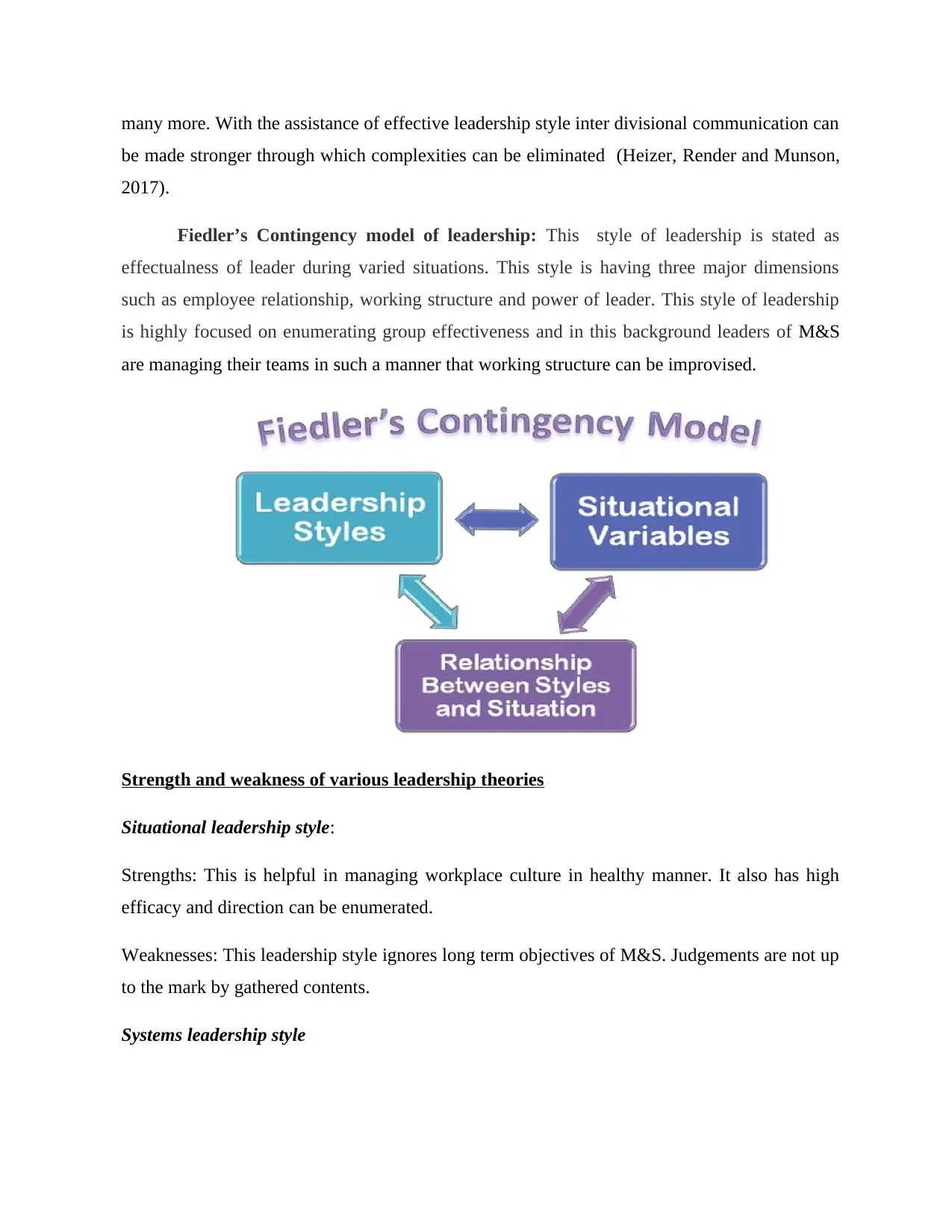
many more. With the assistance of effective leadership style inter divisional communication can
be made stronger through which complexities can be eliminated (Heizer, Render and Munson,
2017).
Fiedler’s Contingency model of leadership: This style of leadership is stated as
effectualness of leader during varied situations. This style is having three major dimensions
such as employee relationship, working structure and power of leader. This style of leadership
is highly focused on enumerating group effectiveness and in this background leaders of M&S
are managing their teams in such a manner that working structure can be improvised.
Strength and weakness of various leadership theories
Situational leadership style:
Strengths: This is helpful in managing workplace culture in healthy manner. It also has high
efficacy and direction can be enumerated.
Weaknesses: This leadership style ignores long term objectives of M&S. Judgements are not up
to the mark by gathered contents.
Systems leadership style
be made stronger through which complexities can be eliminated (Heizer, Render and Munson,
2017).
Fiedler’s Contingency model of leadership: This style of leadership is stated as
effectualness of leader during varied situations. This style is having three major dimensions
such as employee relationship, working structure and power of leader. This style of leadership
is highly focused on enumerating group effectiveness and in this background leaders of M&S
are managing their teams in such a manner that working structure can be improvised.
Strength and weakness of various leadership theories
Situational leadership style:
Strengths: This is helpful in managing workplace culture in healthy manner. It also has high
efficacy and direction can be enumerated.
Weaknesses: This leadership style ignores long term objectives of M&S. Judgements are not up
to the mark by gathered contents.
Systems leadership style
⊘ This is a preview!⊘
Do you want full access?
Subscribe today to unlock all pages.

Trusted by 1+ million students worldwide

Strengths: This is associated with personal and overall objective of organisation. Direction is
provided in ample manner in order to create path for overall success.
Weaknesses: Very clumsy process of decision making. Generation of internal conflicts by
which degree of inter-dependence increase.
Contingency leadership style
Strengths: This is a dynamic in nature. After involving team mates in opinion making they feel
valued.
Weaknesses: This is rigid in nature so inhales high business complexities as well. High skills
are needed which is not possible for every business.
PART 2
P4.
In businesses, numerous situations are faced by them in which several theories of
operation management is to be applied so as to earn high profits (Meredith and Shafer, 2019).
Positive implications are drawn of these approaches in M&S in which high business efficacy
and productivity are attained. Some of the approaches are enumerated as under:
Six sigma: This is known as a system in which broad emphasised is put in eliminating
overall defects by adopting highly efficient production processes. This system is associated
with finding out opportunities in which defects can be minimised to 3.4 defects in per million
orders so that to attain high customer satisfaction. With the help of six sigma approach efficacy
can be attained in manufacturing process and quality can be improvised as well. There are six
approaches in six sigma which is called DMAIC and those are elaborated as under:
D-Defining the problem and the project goals
M-Measuring in detail the various aspects of the current process
A- Analysing data to identify defects in a process
I- Improving the process, and
provided in ample manner in order to create path for overall success.
Weaknesses: Very clumsy process of decision making. Generation of internal conflicts by
which degree of inter-dependence increase.
Contingency leadership style
Strengths: This is a dynamic in nature. After involving team mates in opinion making they feel
valued.
Weaknesses: This is rigid in nature so inhales high business complexities as well. High skills
are needed which is not possible for every business.
PART 2
P4.
In businesses, numerous situations are faced by them in which several theories of
operation management is to be applied so as to earn high profits (Meredith and Shafer, 2019).
Positive implications are drawn of these approaches in M&S in which high business efficacy
and productivity are attained. Some of the approaches are enumerated as under:
Six sigma: This is known as a system in which broad emphasised is put in eliminating
overall defects by adopting highly efficient production processes. This system is associated
with finding out opportunities in which defects can be minimised to 3.4 defects in per million
orders so that to attain high customer satisfaction. With the help of six sigma approach efficacy
can be attained in manufacturing process and quality can be improvised as well. There are six
approaches in six sigma which is called DMAIC and those are elaborated as under:
D-Defining the problem and the project goals
M-Measuring in detail the various aspects of the current process
A- Analysing data to identify defects in a process
I- Improving the process, and
Paraphrase This Document
Need a fresh take? Get an instant paraphrase of this document with our AI Paraphraser
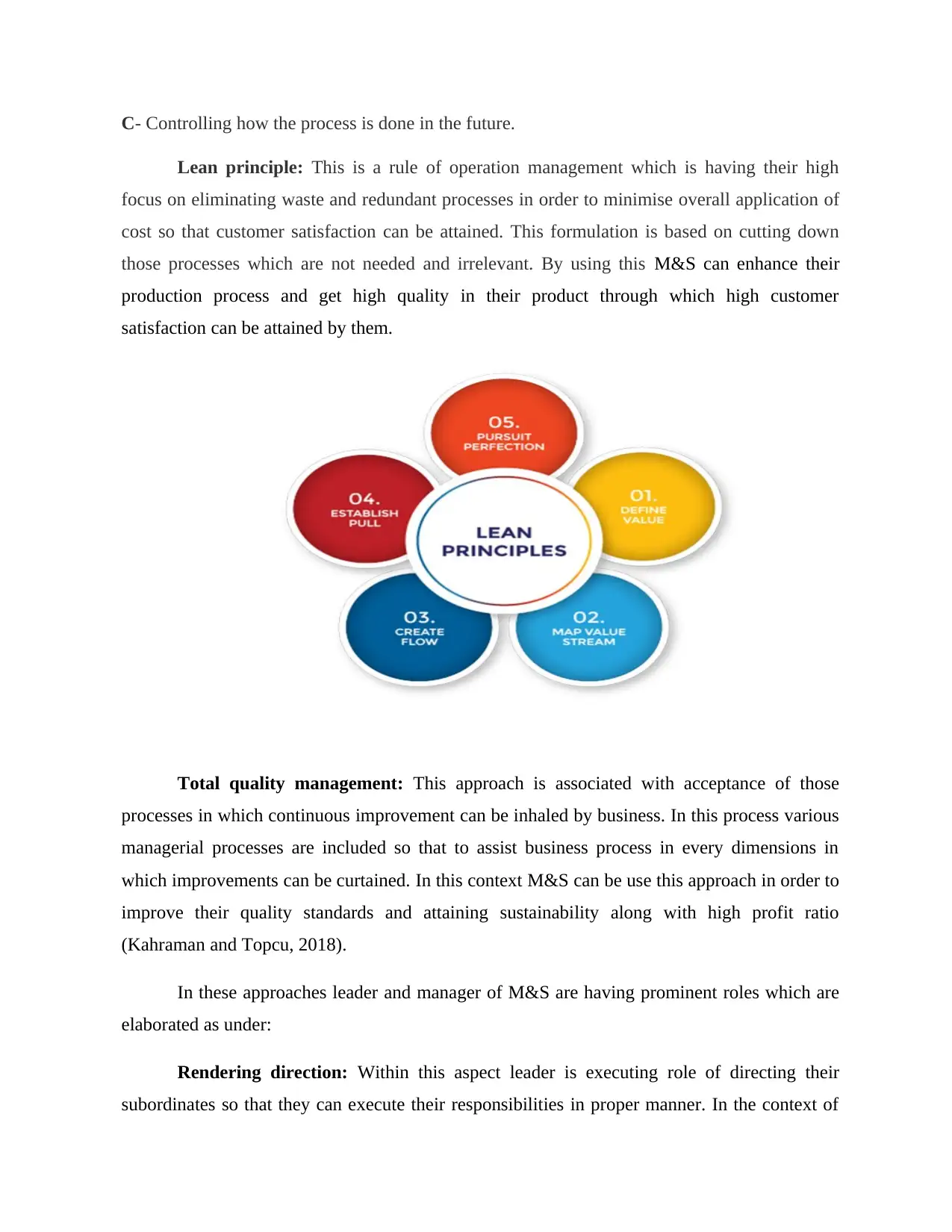
C- Controlling how the process is done in the future.
Lean principle: This is a rule of operation management which is having their high
focus on eliminating waste and redundant processes in order to minimise overall application of
cost so that customer satisfaction can be attained. This formulation is based on cutting down
those processes which are not needed and irrelevant. By using this M&S can enhance their
production process and get high quality in their product through which high customer
satisfaction can be attained by them.
Total quality management: This approach is associated with acceptance of those
processes in which continuous improvement can be inhaled by business. In this process various
managerial processes are included so that to assist business process in every dimensions in
which improvements can be curtained. In this context M&S can be use this approach in order to
improve their quality standards and attaining sustainability along with high profit ratio
(Kahraman and Topcu, 2018).
In these approaches leader and manager of M&S are having prominent roles which are
elaborated as under:
Rendering direction: Within this aspect leader is executing role of directing their
subordinates so that they can execute their responsibilities in proper manner. In the context of
Lean principle: This is a rule of operation management which is having their high
focus on eliminating waste and redundant processes in order to minimise overall application of
cost so that customer satisfaction can be attained. This formulation is based on cutting down
those processes which are not needed and irrelevant. By using this M&S can enhance their
production process and get high quality in their product through which high customer
satisfaction can be attained by them.
Total quality management: This approach is associated with acceptance of those
processes in which continuous improvement can be inhaled by business. In this process various
managerial processes are included so that to assist business process in every dimensions in
which improvements can be curtained. In this context M&S can be use this approach in order to
improve their quality standards and attaining sustainability along with high profit ratio
(Kahraman and Topcu, 2018).
In these approaches leader and manager of M&S are having prominent roles which are
elaborated as under:
Rendering direction: Within this aspect leader is executing role of directing their
subordinates so that they can execute their responsibilities in proper manner. In the context of
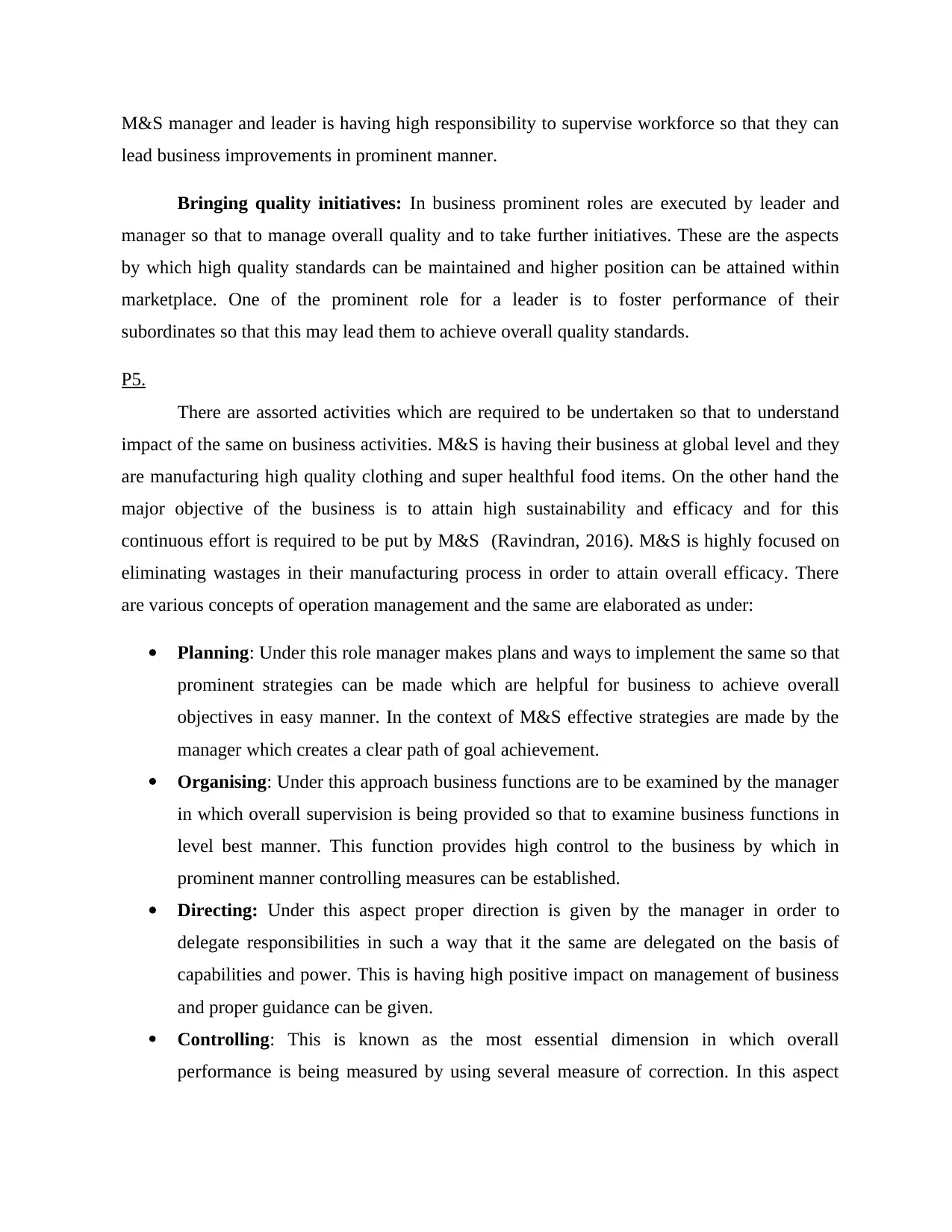
M&S manager and leader is having high responsibility to supervise workforce so that they can
lead business improvements in prominent manner.
Bringing quality initiatives: In business prominent roles are executed by leader and
manager so that to manage overall quality and to take further initiatives. These are the aspects
by which high quality standards can be maintained and higher position can be attained within
marketplace. One of the prominent role for a leader is to foster performance of their
subordinates so that this may lead them to achieve overall quality standards.
P5.
There are assorted activities which are required to be undertaken so that to understand
impact of the same on business activities. M&S is having their business at global level and they
are manufacturing high quality clothing and super healthful food items. On the other hand the
major objective of the business is to attain high sustainability and efficacy and for this
continuous effort is required to be put by M&S (Ravindran, 2016). M&S is highly focused on
eliminating wastages in their manufacturing process in order to attain overall efficacy. There
are various concepts of operation management and the same are elaborated as under:
Planning: Under this role manager makes plans and ways to implement the same so that
prominent strategies can be made which are helpful for business to achieve overall
objectives in easy manner. In the context of M&S effective strategies are made by the
manager which creates a clear path of goal achievement.
Organising: Under this approach business functions are to be examined by the manager
in which overall supervision is being provided so that to examine business functions in
level best manner. This function provides high control to the business by which in
prominent manner controlling measures can be established.
Directing: Under this aspect proper direction is given by the manager in order to
delegate responsibilities in such a way that it the same are delegated on the basis of
capabilities and power. This is having high positive impact on management of business
and proper guidance can be given.
Controlling: This is known as the most essential dimension in which overall
performance is being measured by using several measure of correction. In this aspect
lead business improvements in prominent manner.
Bringing quality initiatives: In business prominent roles are executed by leader and
manager so that to manage overall quality and to take further initiatives. These are the aspects
by which high quality standards can be maintained and higher position can be attained within
marketplace. One of the prominent role for a leader is to foster performance of their
subordinates so that this may lead them to achieve overall quality standards.
P5.
There are assorted activities which are required to be undertaken so that to understand
impact of the same on business activities. M&S is having their business at global level and they
are manufacturing high quality clothing and super healthful food items. On the other hand the
major objective of the business is to attain high sustainability and efficacy and for this
continuous effort is required to be put by M&S (Ravindran, 2016). M&S is highly focused on
eliminating wastages in their manufacturing process in order to attain overall efficacy. There
are various concepts of operation management and the same are elaborated as under:
Planning: Under this role manager makes plans and ways to implement the same so that
prominent strategies can be made which are helpful for business to achieve overall
objectives in easy manner. In the context of M&S effective strategies are made by the
manager which creates a clear path of goal achievement.
Organising: Under this approach business functions are to be examined by the manager
in which overall supervision is being provided so that to examine business functions in
level best manner. This function provides high control to the business by which in
prominent manner controlling measures can be established.
Directing: Under this aspect proper direction is given by the manager in order to
delegate responsibilities in such a way that it the same are delegated on the basis of
capabilities and power. This is having high positive impact on management of business
and proper guidance can be given.
Controlling: This is known as the most essential dimension in which overall
performance is being measured by using several measure of correction. In this aspect
⊘ This is a preview!⊘
Do you want full access?
Subscribe today to unlock all pages.

Trusted by 1+ million students worldwide
1 out of 17
Related Documents
Your All-in-One AI-Powered Toolkit for Academic Success.
+13062052269
info@desklib.com
Available 24*7 on WhatsApp / Email
![[object Object]](/_next/static/media/star-bottom.7253800d.svg)
Unlock your academic potential
Copyright © 2020–2025 A2Z Services. All Rights Reserved. Developed and managed by ZUCOL.





